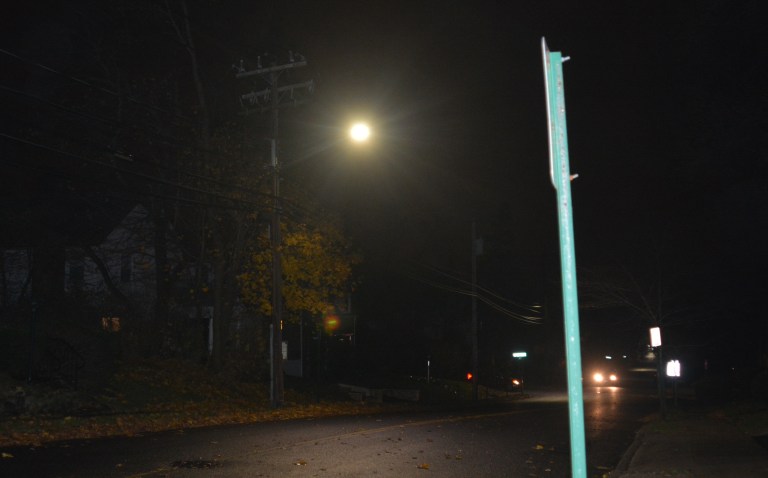
Additional papers have been filed in support of Judith Youngblood’s lawsuit against the Village of Great Neck, including an amended complaint clarifying causes of action and affidavits from five residents.
Youngblood, a 28-year resident of Great Neck, is trying to get an injunction against LED lights near her home. According to court papers, the bulbs “emit high levels of intense light” into her house and make it “impossible to sleep, use and enjoy the home she has lived in.”
The Feb. 7 lawsuit, which requests nearly $1 million in compensatory damages, named Mayor Pedram Bral, the Board of Trustees and Clerk-Treasurer Joe Gill as defendants.
The amended complaint, filed by Tamara Harris, a Manhattan-based attorney representing Youngblood, suggests the Board of Trustees installed high-intensity LED lights throughout the village despite residential protests and offered false assurances that the light would not penetrate any homes.
It also alleges the village’s actions “have caused unreasonable annoyance and alarm to [Youngblood] through the installation of these outrageously bright street lights” and characterized its actions as “unreasonable,” suggesting the village could install less intense lights or turn the ones by Youngblood’s home off.
The papers also mention New York Public Building Law 143 (2), which regulates the installation of unshielded lighting fixtures, and suggests the installation of LED lights with a 4,000 K temperature exceeded legal limits.
Court documents filed by Harris go on to allege the defendants “engaged in an intentional misrepresentation of material existing fact” by saying the lights could be shielded and would not be excessively bright, and that Youngblood did not realize it before the installation of lights near her home on Dec. 8.
The papers also argue that the harm from the lights has effectively deprived Youngblood of the use of her property without due process, as guaranteed by the 14th Amendment of the U.S. Constitution.
Harris also argues in the papers that the lights amount to trespass, since Youngblood never gave permission for their entry into her home.
Five residents from the Village of Great Neck also supplied affidavits in support of Youngblood’s allegations.
The additional documentation came in response to arguments from Andrew Preston of Bee, Ready, Fishbein, Hatter & Donovan LLP, who is representing the village and seeking to get the case dismissed.
In court papers, Preston argued that it is the village’s core mission to “preserve the safety and welfare of village residents and visitors” and that the Court of Appeals “has recognized the self-evident proposition that government should not be prohibited from performing its core missions.”
Preston also said a street lamp is “not a substantial interference,” nor is it “unreasonable in character,” and that if the village was mandated to turn off individual streetlights, it could create “an unsafe condition to the general public and expose the Village to further tort liability.”
Preston also notes that the individual defendants have “absolute legislative immunity” and thus should be dismissed from the case.
When asked for further comment, Preston said, “It is the practice of this office not to comment on pending litigation.”
The Village of Great Neck has installed more than 800 street fixtures with LED bulbs, following presentations and public hearings. Officials have described the installation as a way to improve safety and replace failing lights while reducing energy costs.
According to the American Medical Association, certain LED lights can emit high amounts of blue light that appears white. This in turn, the AMA says, can create nighttime glare, suppress melatonin at night, and affect the circadian rhythm.
The AMA recommends minimizing blue-rich light, using 3,000 K LED lights and lower, and properly shielding lights to minimize adverse health effects.
The Illuminating Engineering Society agrees with the importance of properly installing LED lights with “proper optics and shielding to reduce glare and light trespass.”
The society, however, argues that the 3000 K threshold is not based on science and that melanopic content should be measured instead before conclusions are made.







I seriously heard this woman complaining on the radio about having to use her LL Bean flannels to cover her windows as well as other expensive items. Life must be rough over there in Great Neck! For gods sake lady buy some black out curtains . You don’t deserve a million bucks for this !! Get over yourself!
Go Judith! The whole world is watching and will follow suit.
I appreciate Ms. Youngblood’s bold action. There are many that feel she as she does. For those that think this lawsuit is frivolous, please investigate these links from the AMA, Harvard and others to see just how damaging blue-rich LED’s truly are:
https://www.ama-assn.org/ama-adopts-guidance-reduce-harm-high-intensity-street-lights
https://www.hsph.harvard.edu/news/press-releases/outdoor-light-night-breast-cancer/
https://www.jpost.com/Health-and-Sci-Tech/Health/Study-Nighttime-LED-light-increases-risk-of-cancer
https://www.facebook.com/groups/155084901640186/
https://gizmodo.com/the-switch-to-outdoor-led-lighting-has-completely-backf-1820652615
I looked up in the sky to admire how close Venus is to Earth this time of year while having my morning coffee at 4:30 am. The next day I was blinded by a horrible glare from 12 new LED glaring spotlights that were just placed at the elementary school. The light comes into my bedroom through the darkening blinds so much that I can make shadow puppets on my wall all night long. I totally understand. I cant sleep. I cant sit on my 4 season porch by the fireplace and have my coffee. I cant see stars. I cant see anything in my periferal vision while I am outside in my backyard. I need your lawyer to help me please. Good luck to you.